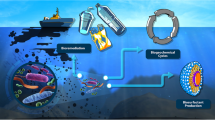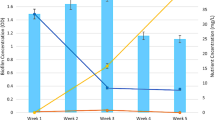Abstract
Petroleum hydrocarbon contamination of groundwater and soil constitutes a serious threat to human health and the natural environment. In situ biodegradation is a low-cost, low-risk and effective technique to remove petroleum hydrocarbon contaminants. The concentrations of total petroleum hydrocarbons (TPH), dissolved inorganic carbon (DIC) and \(^{14} {\text{C}}_{{{\text{HCO}}_{3} }}\) were analyzed, and polymerase chain reaction–denaturing gradient gel electrophoresis was used to investigate bacterial community structures. Downgradient from the contaminated source along the groundwater flow, the concentrations of TPH and DIC decreased and the 14C content increased from 44.3 to 64.3 pmc, which confirmed petroleum hydrocarbon biodegradation in the contaminated aquifers. The sequence analysis of the DGGE bands revealed that some species of known bacterial biodegrading strains, such as Dechloromonas aromatica RCB, Pseudomonas putida and Pseudomonas protegens, were the dominant bacterial groups in the field. Hydrogeochemical and stable isotope measurements, combined with analysis of bacterial community structures, could be useful tools to prove the occurrence of biodegradation processes in contaminated aquifers.







Similar content being viewed by others
References
Aelion CM, Kirtland BC, Stone PA (1997) Radiocarbon assessment of aerobic petroleum bioremediation in the vadose zone and groundwater at an AS/SVE site. Environ Sci Technol 3112:3363–3370
Aggarwal PK, Hinchee RE (1991) Monitoring in situ biodegradation of hydrocarbons by using stable carbon isotopes. Environ Sci Technol 25:1178–1180
Anderson RT, Lovley DR (1997) Ecology and biogeochemistry of in situ groundwater bioremediation. Adv Microb Ecol 15:289–350
Baedecker MJ, Cozzarelli IM, Eganhouse RP, Siegel DI, Bennett PC (1993) Crude oil in a shallow sand and gravel aquifer-III. Biogeochemical reactions and mass balance modeling in anoxic groundwater. Appl Geochem 8:569–586
Bauer JE, Spies RB, Vogel JS, Nelson DE, Southon JR (1990) Radiocarbon evidence of fossil-carbon cycling in sediments of nearshore hydrocarbon seep. Nature 348:230–232
Bauer JE, Williams PM, Druffel ERM (1992) 14C activity of dissolved organic carbon fractions in the north-central Pacific and Sargasso Sea. Nature 357:667–670
Bauer JE, Reimers CE, Druffel ERM, Williams PM (1995) Isotopic constraints on carbon exchange between deep ocean sediments and sea water. Nature 373:686–689
Bhupathiraju VK, Krauter P, Holman H-YN, Conrad ME, Daley PF, Templeton AS, Hunt JR, Hernandez M, Alvarez-Cohen L (2002) Assessment of in situ bioremediation at a refinery waste-contaminated site and an aviation gasoline contaminated site. Biodegradation 13:79–90
Bolliger C, Höhener P, Hunkeler D et al (1999) Intrinsic bioremediation of a petroleum hydrocarbon-contaminated aquifer and assessment of mineralization based on stable carbon isotopes. Biodegradation 10:201–217
Borden RC, Gomez CA, Becker MT (1995) Geochemical indicators of intrinsic bioremediation. Ground Water 33(2):180–189
Bugna GC, Chantona JP, Stauffer TB, MacIntyre WG, Libelo EL (2005) Partitioning microbial respiration between jet fuel and native organic matter in an organic-rich long time-contaminated aquifer. Chemosphere 60:177–187
Chapelle FH, Knobel LL (1986) Stable carbon isotopes of a HCO3 − in the Aquia aquifer, Maryland: evidence for an isotopically heavy source of CO2. Ground Water 23:592–599
Clark I, Fritz P (1997) Environmental isotopes in hydrogeology. Springer, New York
Coates JD, Chakraborty R, Lack JG, O’Connor SM, Cole KA, Bender KS, Achenbach LA (2001) Anaerobic benzene oxidation coupled to nitrate reduction in pure culture by two strains of Dechloromonas. Nature 411(6841):1039–1043
Coffin RB, Pohlman JW, Grabowski KS, Knies DL, Plummer RE, Magee RW, Boyd TJ (2008) Radiocarbon and stable carbon isotope analysis to confirm petroleum natural attenuation in the vadose zone. Environ Forensics 9:75–84
Conrad ME, Depaolo DJ (2004) Carbon isotopic evidence for biodegradation of organic contaminants in the shallow vadose zone of the Radioactive Waste Management complex. Vadose Zone J 3:143–153
Conrad ME, Daley PF, Fischer ML, Buchanan BB, Leighton T, Kashgarian M (1997) Combined 14C and δ 13C monitoring of in situ biodegradation of petroleum hydrocarbons. Environ Sci Technol 31:1463–1469
Douglas GS, McCarthy JK, Dahlen DT, Seavey JA, Steinhauer WG, Prince RC, Elmendorf DL (1992) The use of hydrocarbon analyses for environmental assessment and remediation. J. Soil Contam 1:197–216
Fang J, Barcelona MJ, Krishnamurthy RV et al (2000) Stable carbon isotope biogeochemistry of a shallow sand aquifer contaminated with fuel hydrocarbons. Appl Geochem 15:157–169
Fera MT, Maugeri TL, Gugliandolo C, Beninati C, Giannone M, La Camera E, Carbone M (2004) Detection of Arcobacter spp. in the coastal environment of the Mediterranean Sea. Appl Environ Microbiol 70(3):1271–1276
Fleming JT, Sanseverino J, Sayler GS (1993) Quantitative Relationship between Catabolic Gene Frequency and Expression in Predicting PAH Degradation in Soils at Town Gas Manufactured Sites. Environ Sci Technol 27:1068–1074
Hunkeler D, Hǒhener P, Bernasconi S et al (1999) Engineered in situ bioremediation of a petroleum hydrocarbon-contaminated aquifer: assessment of mineralization based on alkalinity, inorganic carbon and stable isotope balances. J Contam Hydrol 37:201–233
Kanehisa Laboratories (2004) Polycyclic aromatic hydrocarbon degradation—Pseudomonas protegens Pf-5[EB/OL]. http://www.genome.jp/kegg-bin/show_pathway?org_name=pfl&mapno=00624&mapscale=1.0&show_description=show. Accessed 11 June, 2012
Kao CM, Wang YS (2001) Field investigation of the natural attenuation and intrinsic biodegradation rates at an underground storage tank site. Environ Geol 40(4–5):622–631
Kaoa C-M, Chenb CS, Tsab F-Y, Yangc K-H, Chiend C-C, Liangb S-H, Yangb C-A, Chenb SC (2010) Application of real-time PCR, DGGE fingerprinting, and culture-based method to evaluate the effectiveness of intrinsic bioremediation on the control of petroleum-hydrocarbon plume. J Hazard Mater 178:409–416
Kowalski H (2002) U.S.—German Research Consortium Sequences Genome of Versatile Soil Microbe. J Craig Venter Arch. http://www.tigr.org/news/pr_12_02_02.shtml
Landmeyer JE, Vroblesky DA, Chapelle FH (1996) Stable carbon isotope evidence of biodegradation zonation in a shallow jet-fuel contaminated aquifer. Environ Sci Technol 30:1120–1128
Lesage S, Hao X, Kent SN (1997) Distinguishing natural hydrocarbons from anthropogenic contamination in groundwater. Groundwater 35(1):149–160
Lollar BS, Slater GF, Sleep B et al (2001) Stable carbon isotope evidence for intrinsic bioremediation of tetrachloroethene and trichloroethene at area 6, Dover Air Force Base. Environ Sci Technol 352:261–269
Madsen EL, Sinclair JL (1991) Ghiorse WC (1991) In situ biodegradation: microbiological patterns in a contaminated aquifer. Science 252:830–833
Marcus A (2003) Versatile soil-dwelling microbe is mapped. Genome News Netw. http://www.genomenewsnetwork.org/articles/01_03/soil_microbe.shtml
Mouser P, Rizzo D, Röling WM, Vanvreukelen B (2005) A multivariate statistical approach to spatial representation of groundwater contamination using hydrochemistry and microbial community profiles. Environ Sci Technol 39:7551–7559
National Research Council (1993) In situ bioremediation when does it work? National Academy Press, Washington
Revesz K, Coplen TB, Baedecker MJ, Glynn PD, Hult M (1995) Methane production and consumption monitored by stable H and C isotope ratios at a crude oil spill site, Bemidji, Minnesota. Appl Geochem 10:505–516
Salinero KK, Keller K, Feil WS, Feil H (2009) S Trong (2009), Genevieve Di Bartolo and Alla Lapidus. Metabolic analysis of the soil microbe Dechloromonas aromatica str. RCB: indications of a surprisingly complex life-style and cryptic anaerobic pathways for aromatic degradation. BMC Genom 10(351):1–23
Schoell M (1984) Stable isotopes in petroleum research. Adv Pet Geochem 1:215–245
Su X, Lv H, Zhang W, Zhang Y, Jiao X (2013) Evaluation of petroleum hydrocarbon biodegradation in shallow groundwater by hydrogeochemical indicators and C, S-isotopes. Environ Earth Sci 69(6):2091–2101
Suchomel KH, Kreamer DK, Long A (1990) Production and transport of carbon dioxide in a contaminated vadose zone: a stable and radioactive carbon isotope study. Environ Sci Technol 24:1824–1831
Topinkova B, Nesetril K, Datel J (2007) Geochemical heterogeneity and isotope geochemistry of natural attenuation processes in a gasoline-contaminated aquifer at the Hnevice site, Czech Republic. Hydrogeol J 15:961–976
Author information
Authors and Affiliations
Corresponding author
Rights and permissions
About this article
Cite this article
Lv, H., Lin, X., Su, X. et al. 14C Isotopes and microbial community structures as evidence for biodegradation in a petroleum hydrocarbon-contaminated aquifer. Environ Earth Sci 75, 119 (2016). https://doi.org/10.1007/s12665-015-4787-7
Received:
Accepted:
Published:
DOI: https://doi.org/10.1007/s12665-015-4787-7




